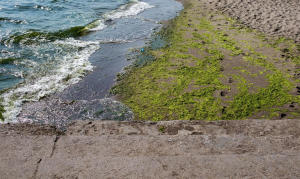Threats associated with phenomenon of the so-called cyanobacteria blooms are more and more commonly monitored, however, new and more precise methods allowing for their early and quick detection are still being developed. Among of novel methods the application of cellular reporter biosensors is getting growing attention. Therefore, the aim of the project and its final effect was to propose a sensitive and specific tool for a more complete and effective monitoring of threats for aquatic ecosystem functioning associated with cyanobacterial blooms. In the present study we used genetically stably modified human cell lines as a biosensors detecting four different types of bioactivities ARE – oxidative stress, NFKBRE – immunomodulatory pathogen-associated molecular patterns, AHRE – persistent organic pollutants, GRE – endocrine disruptors. Our results showed that from among the studied groups of biosensors, two of them: NFKBRE and ARE, showed the highest sensitivity to the presence of toxic compounds produced by cyanobacteria. Moreover, the NFKBRE biosensor demonstrated for the first time the immunomodulatory toxic effect of lipopolysaccharides and lipoproteins associated with the cell membrane of cyanobacteria cells.
Cyanobacteria are among the oldest organisms on Earth. Wide range of adaptations allow them to inhabit a variety of environments such as hot springs, arctic habitats on the surface of rocks, snow, animal fur, inland fresh and brackish waters or marine ecosystems. There are also many symbiotic species that live in symbiosis with other organisms, both terrestrial and aquatic. However, the cyanobacteria living in plankton gather the greatest attention through mass occurrences so-called cyanobacterial blooms. The presence of abundant population of cyanobacteria by itself disrupts the proper functioning of aquatic ecosystems, however, it may pose an additional threat due to cyanotoxins produced by these cyanobacteria during blooms.
Threats associated with this phenomenon are more and more commonly monitored, however, new and more precise methods allowing for their early and quick detection are still being developed. Among of novel methods the application of cellular reporter biosensors is getting growing attention. Biosensors are an emerging class of efficient environmental monitoring tools that allow for quick monitoring of harmful substances in the environment. An important part of biosensors is a sensitive element that recognizes a substance monitored in the environment such as enzymes, whole cells, cell organelles, antigens and antibodies or nucleic acids. In the present study genetically stably modified human cell lines were used as a biosensors detecting four different types of bioactivities ARE – oxidative stress, NFKBRE – immunomodulatory pathogen-associated molecular patterns, AHRE – persistent organic pollutants, GRE – endocrine disruptors. A set of four cellular biosensors were exposed to diverse material of cyanobacterial origin, both from environmental samples as well as from selected cyanobacterial strains, including selected cyanotoxins (microcystins, cylindrospermopsin, anatoxin-a) and other isolated cyanobacterial components such as lipopolysaccharides, lipopeptides, and proteins of the outer membrane. The aim of the project and its final effect was therefore to propose a sensitive and specific tool for a more complete and effective monitoring of threats for aquatic ecosystem functioning associated with cyanobacterial blooms.
Our results showed that from among the studied groups of biosensors, two of them: NFKBRE and ARE, showed the highest sensitivity to the presence of toxic compounds produced by cyanobacteria. In particular, the NFKBRE biosensor was activated both by concentrated environmental samples collected during blooms from various reservoirs and material extracted from cyanobacterial cultures. Moreover, the NFKBRE biosensor demonstrated for the first time the immunomodulatory toxic effect of lipopolysaccharides and lipoproteins associated with the cell membrane of cyanobacteria cells. Thus, these studies provided new knowledge on the possibility of using biosensors in the monitoring of threats related to cyanobacterial blooms including emerging environmental toxicants - in this case, cyanobacterial cell wall components.
References
Burford, M.A., Carey, C.C., Hamilton, D.P., Huisman, J., Paerl, H.W., Wood, S.A., Wulff, A., 2020. Perspective: advancing the research agenda for improving understanding of cyanobacteria in a future of global change. Harmful Algae 91, 101601. https://doi.org/10.1016/j.hal.2019.04.004.
Elad, T., Belkin, S., 2017. Reporter gene assays in ecotoxicology. Adv. Biochem. Eng. Biotechnol. 157, 135–157. https://doi.org/10.1007/10_2016_47.
Mantzouki, E., Campbell, J., van Loon, E., et al., 2018. A EuropeanMulti Lake Survey dataset of environmental variables, phytoplankton pigments and cyanotoxins. Sci. Data. 5, 180226. https://doi.org/10.1038/sdata.2018.226.
Meriluoto, J, Spoof, L, Codd, G.A., 2017. Handbook of cyanobacterial monitoring and cyanotoxin analysis. Wiley, Chichester UK.
Wagner, W., Sachrajda, I., Pułaski, L., Hałatek, T., Dastych, J., 2011. Application of cellular biosensors for analysis of bioactivity associated with airborne particulate matter. Toxicol. in Vitro 25 (5), 1132–1142. https://doi.org/10.1016/j.tiv.2011.03.019
